Mineralogy
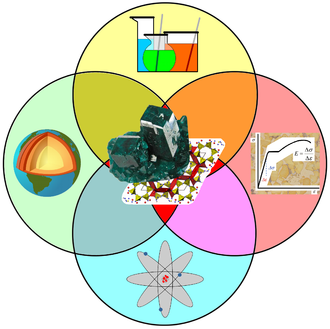
Mineralogy[n 1] is a subject of geology specializing in the scientific study of the chemistry, crystal structure, and physical (including optical) properties of minerals and mineralized artifacts. Specific studies within mineralogy include the processes of mineral origin and formation, classification of minerals, their geographical distribution, as well as their utilization.
History
[edit]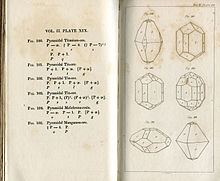
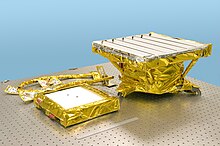
Early writing on mineralogy, especially on gemstones, comes from ancient Babylonia, the ancient Greco-Roman world, ancient and medieval China, and Sanskrit texts from ancient India and the ancient Islamic world.[4] Books on the subject included the Natural History of Pliny the Elder, which not only described many different minerals but also explained many of their properties, and Kitab al Jawahir (Book of Precious Stones) by Persian scientist Al-Biruni. The German Renaissance specialist Georgius Agricola wrote works such as De re metallica (On Metals, 1556) and De Natura Fossilium (On the Nature of Rocks, 1546) which began the scientific approach to the subject. Systematic scientific studies of minerals and rocks developed in post-Renaissance Europe.[4] The modern study of mineralogy was founded on the principles of crystallography (the origins of geometric crystallography, itself, can be traced back to the mineralogy practiced in the eighteenth and nineteenth centuries) and to the microscopic study of rock sections with the invention of the microscope in the 17th century.[4]
Nicholas Steno first observed the law of constancy of interfacial angles (also known as the first law of crystallography) in quartz crystals in 1669.[5]: 4 This was later generalized and established experimentally by Jean-Baptiste L. Romé de l'Islee in 1783.[6] René Just Haüy, the "father of modern crystallography", showed that crystals are periodic and established that the orientations of crystal faces can be expressed in terms of rational numbers, as later encoded in the Miller indices.[5]: 4 In 1814, Jöns Jacob Berzelius introduced a classification of minerals based on their chemistry rather than their crystal structure.[7] William Nicol developed the Nicol prism, which polarizes light, in 1827–1828 while studying fossilized wood; Henry Clifton Sorby showed that thin sections of minerals could be identified by their optical properties using a polarizing microscope.[5]: 4 [7]: 15 James D. Dana published his first edition of A System of Mineralogy in 1837, and in a later edition introduced a chemical classification that is still the standard.[5]: 4 [7]: 15 X-ray diffraction was demonstrated by Max von Laue in 1912, and developed into a tool for analyzing the crystal structure of minerals by the father/son team of William Henry Bragg and William Lawrence Bragg.[5]: 4
More recently, driven by advances in experimental technique (such as neutron diffraction) and available computational power, the latter of which has enabled extremely accurate atomic-scale simulations of the behaviour of crystals, the science has branched out to consider more general problems in the fields of inorganic chemistry and solid-state physics. It, however, retains a focus on the crystal structures commonly encountered in rock-forming minerals (such as the perovskites, clay minerals and framework silicates). In particular, the field has made great advances in the understanding of the relationship between the atomic-scale structure of minerals and their function; in nature, prominent examples would be accurate measurement and prediction of the elastic properties of minerals, which has led to new insight into seismological behaviour of rocks and depth-related discontinuities in seismograms of the Earth's mantle. To this end, in their focus on the connection between atomic-scale phenomena and macroscopic properties, the mineral sciences (as they are now commonly known) display perhaps more of an overlap with materials science than any other discipline.
Physical properties
[edit]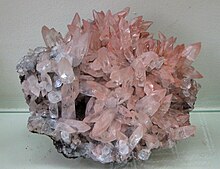
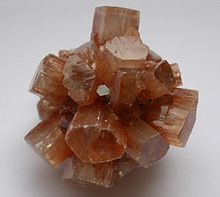
An initial step in identifying a mineral is to examine its physical properties, many of which can be measured on a hand sample. These can be classified into density (often given as specific gravity); measures of mechanical cohesion (hardness, tenacity, cleavage, fracture, parting); macroscopic visual properties (luster, color, streak, luminescence, diaphaneity); magnetic and electric properties; radioactivity and solubility in hydrogen chloride (HCl).[5]: 97–113 [8]: 39–53
Hardness is determined by comparison with other minerals. In the Mohs scale, a standard set of minerals are numbered in order of increasing hardness from 1 (talc) to 10 (diamond). A harder mineral will scratch a softer, so an unknown mineral can be placed in this scale, by which minerals; it scratches and which scratch it. A few minerals such as calcite and kyanite have a hardness that depends significantly on direction.[9]: 254–255 Hardness can also be measured on an absolute scale using a sclerometer; compared to the absolute scale, the Mohs scale is nonlinear.[8]: 52
Tenacity refers to the way a mineral behaves, when it is broken, crushed, bent or torn. A mineral can be brittle, malleable, sectile, ductile, flexible or elastic. An important influence on tenacity is the type of chemical bond (e.g., ionic or metallic).[9]: 255–256
Of the other measures of mechanical cohesion, cleavage is the tendency to break along certain crystallographic planes. It is described by the quality (e.g., perfect or fair) and the orientation of the plane in crystallographic nomenclature.
Parting is the tendency to break along planes of weakness due to pressure, twinning or exsolution. Where these two kinds of break do not occur, fracture is a less orderly form that may be conchoidal (having smooth curves resembling the interior of a shell), fibrous, splintery, hackly (jagged with sharp edges), or uneven.[9]: 253–254
If the mineral is well crystallized, it will also have a distinctive crystal habit (for example, hexagonal, columnar, botryoidal) that reflects the crystal structure or internal arrangement of atoms.[8]: 40–41 It is also affected by crystal defects and twinning. Many crystals are polymorphic, having more than one possible crystal structure depending on factors such as pressure and temperature.[5]: 66–68 [8]: 126
Crystal structure
[edit]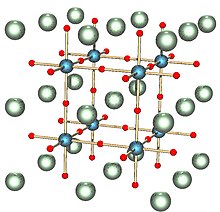
The crystal structure is the arrangement of atoms in a crystal. It is represented by a lattice of points which repeats a basic pattern, called a unit cell, in three dimensions. The lattice can be characterized by its symmetries and by the dimensions of the unit cell. These dimensions are represented by three Miller indices.[11]: 91–92 The lattice remains unchanged by certain symmetry operations about any given point in the lattice: reflection, rotation, inversion, and rotary inversion, a combination of rotation and reflection. Together, they make up a mathematical object called a crystallographic point group or crystal class. There are 32 possible crystal classes. In addition, there are operations that displace all the points: translation, screw axis, and glide plane. In combination with the point symmetries, they form 230 possible space groups.[11]: 125–126
Most geology departments have X-ray powder diffraction equipment to analyze the crystal structures of minerals.[8]: 54–55 X-rays have wavelengths that are the same order of magnitude as the distances between atoms. Diffraction, the constructive and destructive interference between waves scattered at different atoms, leads to distinctive patterns of high and low intensity that depend on the geometry of the crystal. In a sample that is ground to a powder, the X-rays sample a random distribution of all crystal orientations.[12] Powder diffraction can distinguish between minerals that may appear the same in a hand sample, for example quartz and its polymorphs tridymite and cristobalite.[8]: 54
Isomorphous minerals of different compositions have similar powder diffraction patterns, the main difference being in spacing and intensity of lines. For example, the NaCl (halite) crystal structure is space group Fm3m; this structure is shared by sylvite (KCl), periclase (MgO), bunsenite (NiO), galena (PbS), alabandite (MnS), chlorargyrite (AgCl), and osbornite (TiN).[9]: 150–151
Chemical elements
[edit]
A few minerals are chemical elements, including sulfur, copper, silver, and gold, but the vast majority are compounds. The classical method for identifying composition is wet chemical analysis, which involves dissolving a mineral in an acid such as hydrochloric acid (HCl). The elements in solution are then identified using colorimetry, volumetric analysis or gravimetric analysis.[9]: 224–225
Since 1960, most chemistry analysis is done using instruments. One of these, atomic absorption spectroscopy, is similar to wet chemistry in that the sample must still be dissolved, but it is much faster and cheaper. The solution is vaporized and its absorption spectrum is measured in the visible and ultraviolet range.[9]: 225–226 Other techniques are X-ray fluorescence, electron microprobe analysis atom probe tomography and optical emission spectrography.[9]: 227–232
Optical
[edit]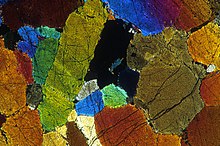
In addition to macroscopic properties such as colour or lustre, minerals have properties that require a polarizing microscope to observe.
Transmitted light
[edit]When light passes from air or a vacuum into a transparent crystal, some of it is reflected at the surface and some refracted. The latter is a bending of the light path that occurs because the speed of light changes as it goes into the crystal; Snell's law relates the bending angle to the Refractive index, the ratio of speed in a vacuum to speed in the crystal. Crystals whose point symmetry group falls in the cubic system are isotropic: the index does not depend on direction. All other crystals are anisotropic: light passing through them is broken up into two plane polarized rays that travel at different speeds and refract at different angles.[9]: 289–291
A polarizing microscope is similar to an ordinary microscope, but it has two plane-polarized filters, a (polarizer) below the sample and an analyzer above it, polarized perpendicular to each other. Light passes successively through the polarizer, the sample and the analyzer. If there is no sample, the analyzer blocks all the light from the polarizer. However, an anisotropic sample will generally change the polarization so some of the light can pass through. Thin sections and powders can be used as samples.[9]: 293–294
When an isotropic crystal is viewed, it appears dark because it does not change the polarization of the light. However, when it is immersed in a calibrated liquid with a lower index of refraction and the microscope is thrown out of focus, a bright line called a Becke line appears around the perimeter of the crystal. By observing the presence or absence of such lines in liquids with different indices, the index of the crystal can be estimated, usually to within ± 0.003.[9]: 294–295
Systematic
[edit]
Systematic mineralogy is the identification and classification of minerals by their properties. Historically, mineralogy was heavily concerned with taxonomy of the rock-forming minerals. In 1959, the International Mineralogical Association formed the Commission of New Minerals and Mineral Names to rationalize the nomenclature and regulate the introduction of new names. In July 2006, it was merged with the Commission on Classification of Minerals to form the Commission on New Minerals, Nomenclature, and Classification.[13] There are over 6,000 named and unnamed minerals, and about 100 are discovered each year.[14] The Manual of Mineralogy places minerals in the following classes: native elements, sulfides, sulfosalts, oxides and hydroxides, halides, carbonates, nitrates and borates, sulfates, chromates, molybdates and tungstates, phosphates, arsenates and vanadates, and silicates.[9]
Formation environments
[edit]The environments of mineral formation and growth are highly varied, ranging from slow crystallization at the high temperatures and pressures of igneous melts deep within the Earth's crust to the low temperature precipitation from a saline brine at the Earth's surface.
Various possible methods of formation include:[15]
- sublimation from volcanic gases
- deposition from aqueous solutions and hydrothermal brines
- crystallization from an igneous magma or lava
- recrystallization due to metamorphic processes and metasomatism
- crystallization during diagenesis of sediments
- formation by oxidation and weathering of rocks exposed to the atmosphere or within the soil environment.
Biomineralogy
[edit]Biomineralogy is a cross-over field between mineralogy, paleontology and biology. It is the study of how plants and animals stabilize minerals under biological control, and the sequencing of mineral replacement of those minerals after deposition.[16] It uses techniques from chemical mineralogy, especially isotopic studies, to determine such things as growth forms in living plants and animals[17][18] as well as things like the original mineral content of fossils.[19]
A new approach to mineralogy called mineral evolution explores the co-evolution of the geosphere and biosphere, including the role of minerals in the origin of life and processes as mineral-catalyzed organic synthesis and the selective adsorption of organic molecules on mineral surfaces.[20][21]
Mineral ecology
[edit]In 2011, several researchers began to develop a Mineral Evolution Database.[22] This database integrates the crowd-sourced site Mindat.org, which has over 690,000 mineral-locality pairs, with the official IMA list of approved minerals and age data from geological publications.[23]
This database makes it possible to apply statistics to answer new questions, an approach that has been called mineral ecology. One such question is how much of mineral evolution is deterministic and how much the result of chance. Some factors are deterministic, such as the chemical nature of a mineral and conditions for its stability; but mineralogy can also be affected by the processes that determine a planet's composition. In a 2015 paper, Robert Hazen and others analyzed the number of minerals involving each element as a function of its abundance. They found that Earth, with over 4800 known minerals and 72 elements, has a power law relationship. The Moon, with only 63 minerals and 24 elements (based on a much smaller sample) has essentially the same relationship. This implies that, given the chemical composition of the planet, one could predict the more common minerals. However, the distribution has a long tail, with 34% of the minerals having been found at only one or two locations. The model predicts that thousands more mineral species may await discovery or have formed and then been lost to erosion, burial or other processes. This implies a role of chance in the formation of rare minerals occur.[24][25][26][27]
In another use of big data sets, network theory was applied to a dataset of carbon minerals, revealing new patterns in their diversity and distribution. The analysis can show which minerals tend to coexist and what conditions (geological, physical, chemical and biological) are associated with them. This information can be used to predict where to look for new deposits and even new mineral species.[28][29][30]
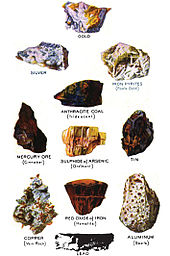
Uses
[edit]Minerals are essential to various needs within human society, such as minerals used as ores for essential components of metal products used in various commodities and machinery, essential components to building materials such as limestone, marble, granite, gravel, glass, plaster, cement, etc.[15] Minerals are also used in fertilizers to enrich the growth of agricultural crops.
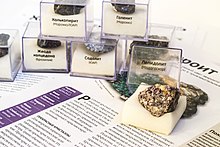
Collecting
[edit]Mineral collecting is also a recreational study and collection hobby, with clubs and societies representing the field.[32][33] Museums, such as the Smithsonian National Museum of Natural History Hall of Geology, Gems, and Minerals, the Natural History Museum of Los Angeles County, the Carnegie Museum of Natural History, the Natural History Museum, London, and the private Mim Mineral Museum in Beirut, Lebanon,[34][35] have popular collections of mineral specimens on permanent display.[36]
See also
[edit]Notes
[edit]- ^ Commonly pronounced /ˌmɪnəˈrɒlədʒi/[1][2] due to the common phonological process of anticipatory assimilation, especially in North-American but also in UK English. Nevertheless, even modern descriptive UK dictionaries tend to record only the spelling pronunciation /ˌmɪnəˈrælədʒi/, sometimes even while their sound file instead has the assimilated pronunciation, as in the case of the Collins Dictionary.[2][failed verification]
References
[edit]- ^ "mineralogy". The American Heritage Dictionary of the English Language (5th ed.). HarperCollins. Retrieved 2017-10-19.
- ^ a b "mineralogy". CollinsDictionary.com. HarperCollins. Retrieved 2017-10-19.
- ^ "NASA Instrument Inaugurates 3-D Moon Imaging". JPL. Archived from the original on 1 January 2009. Retrieved 19 December 2008.
- ^ a b c Needham, Joseph (1959). Science and civilisation in China. Cambridge: Cambridge University Press. pp. 637–638. ISBN 978-0521058018.
- ^ a b c d e f g Nesse, William D. (2012). Introduction to mineralogy (2nd ed.). New York: Oxford University Press. ISBN 978-0199827381.
- ^ "Law of the constancy of interfacial angles". Online dictionary of crystallography. International Union of Crystallography. 24 August 2014. Archived from the original on 19 October 2016. Retrieved 22 September 2015.
- ^ a b c Rafferty, John P. (2012). Geological sciences (1st ed.). New York: Britannica Educational Pub. in association with Rosen Educational Services. pp. 14–15. ISBN 9781615304950.
- ^ a b c d e f Klein, Cornelis; Philpotts, Anthony R. (2013). Earth materials : introduction to mineralogy and petrology. New York: Cambridge University Press. ISBN 9780521145213.
- ^ a b c d e f g h i j k Klein, Cornelis; Hurlbut, Cornelius S. Jr. (1993). Manual of mineralogy : (after James D. Dana) (21st ed.). New York: Wiley. ISBN 047157452X.
- ^ Sharp, T. (27 November 2014). "Bridgmanite – named at last". Science. 346 (6213): 1057–1058. Bibcode:2014Sci...346.1057S. doi:10.1126/science.1261887. PMID 25430755. S2CID 206563252.
- ^ a b Ashcroft, Neil W.; Mermin, N. David (1977). Solid state physics (27. repr. ed.). New York: Holt, Rinehart and Winston. ISBN 9780030839931.
- ^ Dinnebier, Robert E.; Billinge, Simon J.L. (2008). "1. Principles of powder diffraction". In Dinnebier, Robert E.; Billinge, Simon J.L. (eds.). Powder diffraction : theory and practice (Repr. ed.). Cambridge: Royal Society of Chemistry. pp. 1–19. ISBN 9780854042319.
- ^ Parsons, Ian (October 2006). "International Mineralogical Association". Elements. 2 (6): 388. doi:10.2113/gselements.2.6.388.
- ^ Higgins, Michael D.; Smith, Dorian G. W. (October 2010). "A census of mineral species in 2010". Elements. 6 (5): 346.
- ^ a b Moses, Alfred J. (1918–1920). "Mineralogy". In Ramsdell, Lewis S. (ed.). Encyclopedia Americana: International Edition. Vol. 19. New York: Americana Corporation. pp. 164–168.
- ^ Scurfield, Gordon (1979). "Wood Petrifaction: an aspect of biomineralogy". Australian Journal of Botany. 27 (4): 377–390. doi:10.1071/bt9790377.
- ^ Christoffersen, M.R.; Balic-Zunic, T.; Pehrson, S.; Christoffersen, J. (2001). "Kinetics of Growth of Columnar Triclinic Calcium Pyrophosphate Dihydrate Crystals". Crystal Growth & Design. 1 (6): 463–466. doi:10.1021/cg015547j.
- ^ Chandrajith, R.; Wijewardana, G.; Dissanayake, C.B.; Abeygunasekara, A. (2006). "Biomineralogy of human urinary calculi (kidney stones) from some geographic regions of Sri Lanka". Environmental Geochemistry and Health. 28 (4): 393–399. doi:10.1007/s10653-006-9048-y. PMID 16791711. S2CID 24627795.
- ^ Lowenstam, Heitz A (1954). "Environmental relations of modification compositions of certain carbonate secreting marine invertebrates". Proceedings of the National Academy of Sciences of the United States of America. 40 (1): 39–48. Bibcode:1954PNAS...40...39L. doi:10.1073/pnas.40.1.39. PMC 527935. PMID 16589423. Archived from the original on 2015-10-16. Retrieved 2017-07-04.
- ^ Amos, Jonathan (13 February 2016). "Earth's rarest minerals catalogued". BBC News. Archived from the original on 23 November 2018. Retrieved 17 September 2016.
- ^ Hazen, Robert M.; Papineau, Dominic; Bleeker, Wouter; Downs, Robert T.; Ferry, John M.; et al. (November–December 2008). "Mineral Evolution". American Mineralogist. 93 (11–12): 1693–1720. Bibcode:2008AmMin..93.1693H. doi:10.2138/am.2008.2955. S2CID 27460479.
- ^ Hazen, R. M.; Bekker, A.; Bish, D. L.; Bleeker, W.; Downs, R. T.; Farquhar, J.; Ferry, J. M.; Grew, E. S.; Knoll, A. H.; Papineau, D.; Ralph, J. P.; Sverjensky, D. A.; Valley, J. W. (24 June 2011). "Needs and opportunities in mineral evolution research". American Mineralogist. 96 (7): 953–963. Bibcode:2011AmMin..96..953H. doi:10.2138/am.2011.3725. S2CID 21530264.
- ^ Golden, Joshua; Pires, Alexander J.; Hazenj, Robert M.; Downs, Robert T.; Ralph, Jolyon; Meyer, Michael Bruce (2016). Building the mineral evolution database: implications for future big data analysis. GSA Annual Meeting. Denver, Colorado. doi:10.1130/abs/2016AM-286024.
- ^ Hazen, Robert M.; Grew, Edward S.; Downs, Robert T.; Golden, Joshua; Hystad, Grethe (March 2015). "Mineral ecology: Chance and necessity in the mineral diversity of terrestrial planets". The Canadian Mineralogist. 53 (2): 295–324. doi:10.3749/canmin.1400086. S2CID 10969988.
- ^ Hazen, Robert. "Mineral Ecology". Carnegie Science. Archived from the original on 28 May 2018. Retrieved 15 May 2018.
- ^ Kwok, Roberta (11 August 2015). "Is Mineral Evolution Driven by Chance?". Quanta Magazine. Archived from the original on 26 August 2018. Retrieved 11 August 2018.
- ^ Kwok, Roberta (16 August 2015). "How Life and Luck Changed Earth's Minerals". Wired. Archived from the original on 17 July 2017. Retrieved 24 August 2018.
- ^ Oleson, Timothy (1 May 2018). "Data-driven discovery reveals Earth's missing minerals". Earth Magazine. American Geosciences Institute. Archived from the original on 23 August 2018. Retrieved 26 August 2018.
- ^ Hooper, Joel (2 August 2017). "Data mining: How digging through big data can turn up new". Cosmos. Archived from the original on 26 August 2018. Retrieved 26 August 2018.
- ^ Rogers, Nala (1 August 2017). "How Math Can Help Geologists Discover New Minerals". Inside Science. Archived from the original on 27 August 2018. Retrieved 26 August 2018.
- ^ The Encyclopedia Americana. New York: Encyclopedia Americana Corp. 1918–1920. plate opposite p. 166.
- ^ "Collector's Corner". The Mineralogical Society of America. Archived from the original on 2010-06-19. Retrieved 2010-05-22.
- ^ "The American Federation of Mineral Societies". Archived from the original on 2017-07-22. Retrieved 2010-05-22.
- ^ Wilson, W (2013). "The Opening of the Mim Mineral Museum in Beirut, Lebanon". The Mineralogical Record. 45 (1): 61–83.
- ^ Lyckberg, Peter (16 October 2013). "The MIM Museum opening, Lebanon". Mindat.org. Archived from the original on 26 October 2013. Retrieved 19 October 2017.
- ^ "Gems and Minerals". Natural History Museum of Los Angeles. Archived from the original on 2010-05-31. Retrieved 2010-05-22.
Further reading
[edit]- Gribble, C.D.; Hall, A.J. (1993). Optical Mineralogy: Principles And Practice. London: CRC Press. ISBN 9780203498705.
- Harrell, James A. (2012). "Mineralogy". In Bagnall, Roger S.; Brodersen, Kai; Champion, Craige B.; Erskine, Andrew (eds.). The encyclopedia of ancient history. Malden, MA: Wiley-Blackwell. doi:10.1002/9781444338386.wbeah21217. ISBN 9781444338386.
- Hazen, Robert M. (1984). "Mineralogy: A historical review" (PDF). Journal of Geological Education. 32 (5): 288–298. Bibcode:1984JGeoE..32..288H. doi:10.5408/0022-1368-32.5.288. Archived (PDF) from the original on 28 September 2017. Retrieved 27 September 2017.
- Laudan, Rachel (1993). From mineralogy to geology : the foundations of a science, 1650-1830 (Pbk. ed.). Chicago: University of Chicago Press. ISBN 9780226469478.
- Oldroyd, David (1998). Sciences of the earth : studies in the history of mineralogy and geology. Aldershot: Ashgate. ISBN 9780860787709.
- Perkins, Dexter (2014). Mineralogy. Pearson Higher Ed. ISBN 9780321986573.
- Rapp, George R. (2002). Archaeomineralogy. Berlin, Heidelberg: Springer Berlin Heidelberg. ISBN 9783662050057.
- Tisljar, S.K. Haldar, Josip (2013). Introduction to mineralogy and petrology. Burlington: Elsevier Science. ISBN 9780124167100.
{{cite book}}: CS1 maint: multiple names: authors list (link) - Wenk, Hans-Rudolf; Bulakh, Andrey (2016). Minerals: Their Constitution and Origin. Cambridge University Press. ISBN 9781316425282.
- Whewell, William (2010). "Book XV. History of Mineralogy". History of the Inductive Sciences: From the Earliest to the Present Times. Cambridge University Press. pp. 187–252. ISBN 9781108019262.
External links
[edit]Associations
[edit]- American Federation of Mineral Societies
- French Society of Mineralogy and Crystallography
- Geological Society of America
- German Mineralogical Society
- International Mineralogical Association
- Italian Mineralogical and Petrological Society
- Mineralogical Association of Canada
- Mineralogical Society of Great Britain and Ireland
- Mineralogical Society of America


